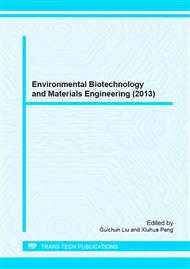p.274
p.280
p.286
p.291
p.296
p.303
p.309
p.314
p.318
Improvement of Operational Performance of MBR with the Emphasis on Enhanced N and P Removal by Modification in Design
Abstract:
Membrane bio-reactor (MBR) is an innovative and effective wastewater treatment process, which has much more extra advantages than other processes. However, membrane fouling and high operational/maintenance costs are always two important factors that restrict the development of MBR. In order to alleviate membrane fouling, larger aeration rate is usually used, which increases the operational cost and decrease N and P removal efficiencies of MBR. This paper summarizes the pilot scale experimental study on the improvement of operational performance of MBR by its design modification from one cell into three cells with micro-aeration,normal aeration and enhanced aeration conditions respectively with the package of fibrous bio-film carrier and PAC. As the result, the effluent water quality was improved significantly and membrane fouling was alleviated remarkably.
Info:
Periodical:
Pages:
296-302
Citation:
Online since:
September 2013
Authors:
Price:
Сopyright:
© 2013 Trans Tech Publications Ltd. All Rights Reserved
Share:
Citation:



